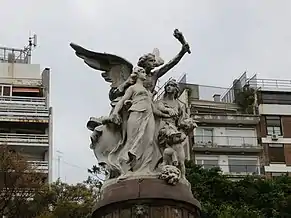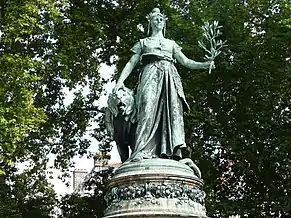Émile Peynot
Émile Edmond Jean Peynot (November 22, 1850 – December 12, 1932) was a prominent French artist and sculptor.
Émile Peynot | |
|---|---|
 Émile Peynot by Charles Mengin | |
| Born | Émile Edmond Jean Peynot November 22, 1850 |
| Died | December 12, 1932 (aged 82) |
| Awards | Prix de Rome (1880) |
Bio
Peynot was born in Villeneuve-sur-Yonne, Burgundy. He became well-known following his Grand Prize at the Prix de Rome sculpture competition in 1880,[1] and a left a legacy of numerous monuments and reliefs in France as well as Argentina and Ecuador. He died in Paris in 1932.
Famous works
- Marianne, Place Carnot, Lyon.
- Monument to Henri Schneider, Le Creusot.[2]
- Monument to François-Louis Français, Plombières-les-Bains, Vosges.
- Marchand Tunisien ("Tunisian Mechant"), portraying an Arab merchant cleaning his weapon.[3]
- La Aurora ("The Twilight"), Parque Centenario, Buenos Aires.
- Ofrenda Floral a Sarmiento ("Flowers for Sarmiento"), Palermo Rose Garden, Buenos Aires.
- La Lucha Eterna ("The Eternal Fight"), El Ejido park, Quito.
- Francia a la Argentina A gift from the French government created for Argentina centenary in 1910; it depicts two female figures, representing both countries, an angel of prosperity “Gloria” and four smaller figures: Science, Industry, Agriculture and the Arts.
- Sculptures by Émile Peynot
 Francia a la Argentina
Francia a la Argentina François-Louis Français, Plombières-les-Bains
François-Louis Français, Plombières-les-Bains Marianne, Place Carnot, Lyon
Marianne, Place Carnot, Lyon Shield of the City of Paris, Petit Palais
Shield of the City of Paris, Petit Palais Monument to Domingo Sarmiento, Buenos Aires
Monument to Domingo Sarmiento, Buenos Aires
See also
This article is issued from Wikipedia. The text is licensed under Creative Commons - Attribution - Sharealike. Additional terms may apply for the media files.